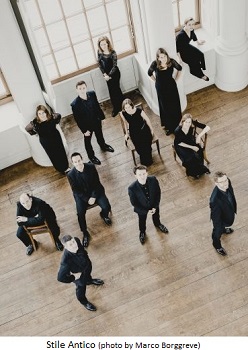Sacred music began tumbling from heaven to earth in the late 16th century, when the words it was sung to became something more than liturgical reference points. It took on more qualities of human speech and a greater intensity of meaning. The turn of that century was the essential tipping point from the rules-based music of the Renaissance to the more emotion-based music of the early Baroque. Though Tomás Luis de Victoria (1548-1611) lived and worked right through that tipping point, his music always seemed to me distanced from it – until I heard Stile Antico sing his Tenebrae Responsories on April 8.
The England-based group – presented every other year by New York’s Music Before 1800 series – has never fallen into line with the British choral tradition, eschewing the ceaselessly ethereal blend of The Tallis Scholars that makes everything sound like Palestrina. No, Stile Antico goes for something with less radiance, more contour, and a more specific realization of the composer’s personality and the character of the piece itself.
 In its early years, Stile Antico was criticized for sounding feral (relative to other Renaissance music groups) – no polyphonic Advil for them. But in these Victoria pieces for Holy Week – as heard both on a new Harmonia Mundi disc and, especially, at Corpus Christi Church on that Sunday – Stile Antico sounds almost angry, and with reasons to be found in the very heart of the music.
In its early years, Stile Antico was criticized for sounding feral (relative to other Renaissance music groups) – no polyphonic Advil for them. But in these Victoria pieces for Holy Week – as heard both on a new Harmonia Mundi disc and, especially, at Corpus Christi Church on that Sunday – Stile Antico sounds almost angry, and with reasons to be found in the very heart of the music.
“Come, let us put poison in his bread and root him out of the land of the living,” reads one line of text from the Holy Thursday Tenebrae service. Such words ask for an emotionally charged delivery: This is the Passion: the story of Judas’s betrayal, Peter’s denial, and all the other insults that Jesus Christ suffered that final night and day. Time and again, Stile Antico’s expression of all this took the form of a particularly dramatic voice popping out of the texture, or enunciation more crisp and cutting than usual. The line “Strangers have risen up against me and the mighty have sought my soul” carried a sense of genuine outrage. Sometimes, there was inner fire; other times, crestfallen resignation, as in the line about Christ’s crucifixion, “bowing his head, he gave up the ghost.”
Whether or not such an approach is historically responsible can be debated by scholars for generations. We know that composers such as Carlo Gesualdo (1566-1613) were exploring more personal means of expression at that time. And he was hardly alone in doing so: look, for instance, at the less-tortured but just-as-adventurous Sigismondo d’India (1582-1629). Even if you weren’t consciously thinking about the historical justification for their emotive delivery, Stile Antico’s arresting readings never felt imposed upon Victoria’s writing. Often, I couldn’t help feeling that these singers had unleashed rhetorical power that was always there, albeit under the surface.
In his notes for the great DG Archiv box set of Victoria’s sacred works by Ensemble Plus Ultra, director Michael Noone wrote that the composer’s art “is defined by its polished surface, its understatement and its intense sensitivity to the possibilities of the human voice.” I don’t exactly disagree with that now, but I would say it’s hardly the whole story. (And not just for the Tenebrae Responsories, as spot-checks in that box set show.) By no means have the inner tension and charged emotion in Victoria’s music been ignored by past performers – they just haven’t gotten the more decisive treatment heard from Stile Antico.


Good summary, thanks.
Grew up with Tallis Scholars, but the more I learned the less apt their style seemed when poured over most of the scared music they sang. This sounds like a major leap forward for early music aficionadi and I’m glad they chose Victoria.
That was my experience, too.
Stile Antico aren’t (I’d say) a major leap forward by themselves – there’s been quite a bit of growth and variety in the performance of Renaissance polyphony over the past 20 years or so. Particularly in France, Belgium, and (yes) the States (though our groups don’t get as much wide exposure as they deserve, thanks to what’s become of the CD market).
Did you ever hear Capilla Flamenca while they were around? And you should check out Beauty Farm, Cappella Pratensis, and Utopia.
I’ve actually heard all of those groups, and yes, it’s collectively moving forward, but what I heard from Antico the other day felt like an unusually large step.
Stile Antico will perform as part of the Williams Center for the Arts (Lafayette College, Easton, PA) 2018/19 performance season, on Sunday, October 14, 2 018 at 3:00 p.m. Music from the court of Elizabeth I by Tallis, Byrd, Dowland, de Lassus, Taverner, Ferrabosco, and others. Tickets on sale in June. williamscenter.lafayette.edu
Any relation to the three Ashby sisters in Stile Antico?